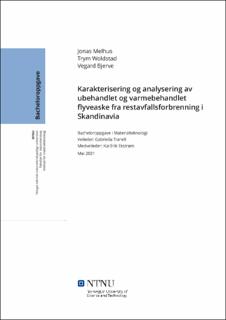| dc.description.abstract | Flyveaske (FA) er et biprodukt fra forbrenning av husholdningsavfall. Sammensetningen i FA vil variere ut ifra hvilken forbrenningsprosess som brukes. De to vanligste er ristovnforbrenning (GF) og virvelsjiktforbrenning (CFB). Grunnet høy pH og innhold av tungmetaller blir FA kategorisert som farlig avfall. Avfallet stabiliseres før det deponeres. Dette leder til at ressursene i FA tas ut av kretsløpet. I denne oppgaven blir enkelte behandlingsmuligheter for virvelsjiktaske (CFBA) og ristovnaske (GFA) vurdert ved hjelp av karakterisering med ulike analyseteknikker som SEM/EDS, XRD og XRF. Med utgangspunkt i analysene ble to alternative behandlingsmetoder undersøkt. Den første metoden bestod av et ovnsforsøk hvor hensikten var å redusere ut rene metallfaser fra FA. Den andre metoden bestod av et karbonatiseringsforsøk hvor hensikten var å se om FA kan brukes til å fange CO2.
De innledende analysene viste relativt stort innhold av metaller i FA, spesielt CFBA. Med utgangspunkt i analysene ble reduksjonsforsøk gjennomført ved 1100°C og 1200°C. Analysene viste også stort innhold av Ca i både CFBA og GFA. Teorien tilsier at CaO/Ca(OH)2 vil reagere med CO2 og denne reaksjon kan akselereres ved økt temperatur. På bakgrunn av dette ble det gjennomført karbonatiseringsforsøk ved 500°C.
Resultatene fra reduksjonsforsøkene viste tydelige metallpartikler i CFBA. Partiklene inneholdt i hovedsak Fe. Reduksjonsforsøk ved 1200°C førte til større ansamlinger av jern enn forsøket ved 1100°C. Analysene etter karbonatiseringsforsøkene viste at karbonater ble dannet som følge av opptak av CO2, for eksempel CaCO3. Resultatene antydet et større opptak av CO2 for GFA enn for CFBA.
Det ble konkludert med at reduksjon av metaller og opptak av CO2 er mulig for FA. Karakterisering av FA viser likheter med tidligere forskning, men viser også at sammensetningen i FA vil variere i ulike deler av verden. Ovnsforsøkene bekreftet potensialet for reduksjon av metaller og CO2-fangst ved hjelp av karbonatisering av FA.
Til slutt er det lagt frem et forslag for videre arbeid. For reduksjons- og karbonatiseringsforsøk vil det være interessant å undersøke hvilke forhold som er best egnet for de to metodene. Forbehandling av FA, temperatur og trykk samt komponenter i atmosfæren under forsøket vil være faktorer som påvirker resultatet og er av interesse for videre arbeid. | |
| dc.description.abstract | Fly ash (FA) is a by-product from municipal solid waste incineration. The composition of FA will vary depending on the incineration process used. The two most common processes are grate furnace incineration (GF) and circulating fluidized bed incineration (CFB). Due to the high pH and the content of heavy metals, FA is categorized as hazardous waste. Because of this the waste is stabilized and then used for landfill, and in the process valuable resources in the FA are lost. In this thesis the scope is to investigate the potential for valorisation of circulating fluidized bed ash (CFBA) and grate furnace ash (GFA). The composition of the ashes was established using different analysis techniques such as SEM/EDS, XRD and XRF. Based on the analysis two alternative valorisation methods were tested. The first method was a furnace experiment where the intention was to reduce pure metal phases from FA. The second method was a carbonation experiment, where the purpose was to see if FA can be used to capture CO2.
The initial analysis showed a relatively high content of metals in FA, especially in CFBA. This is supported by the theory behind CFBA incineration processes. Based on this, reduction experiments were executed at 1100°C and 1200°C. The analysis also displayed a high content of Ca in both CFBA and GFA. The theory states that CaO/Ca(OH)2 will react with CO2 and the reaction can be accelerated at higher temperatures. Therefore, carbonation experiments were done at 500°C.
The results from the reduction experiments showed metal particles in CFBA. The particles contained mainly Fe. Reduction experiments at 1200°C led to larger accumulations of iron than the experiment at 1100°C. The analysis after the carbonation experiments showed that carbonates were formed because of the uptake of CO2, for example CaCO3. The results indicate a greater capture of CO2 for GFA than for CFBA.
It was concluded that reduction of metals and capture of CO2 is possible for FA. Even though the composition of FA analyzed in this thesis shows similarities with FA from previous research, the results indicates that the composition varies around the world. The furnace experiments confirmed the potential for reduction of metals and CO2 capture utilizing carbonation in FA.
Finally, suggestions for further work are presented. For the reduction and carbonation experiments, an interesting possibility is to investigate which conditions are best suited for each of the two methods. Pre-treatment of FA, temperature and pressure, as well as the atmosphere during the experiments are factors that affect the result and should be looked further into. | |
